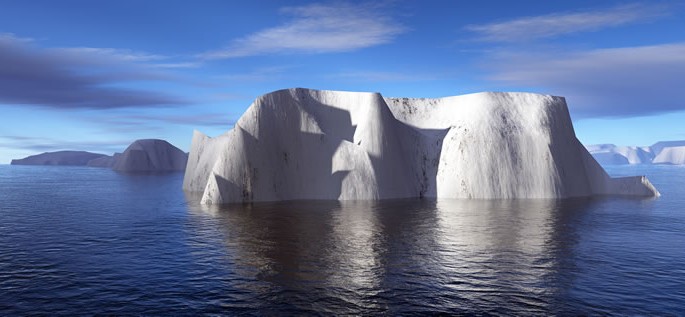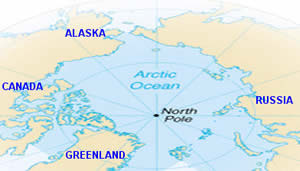
Inuit/Inupiaq
The term Inuit (plural of Inuk ‘man’) refers to a group of indigenous peoples of the circumpolar regions of Alaska, Canada, and Greenland. The term is also used for the continuum of language varieties spoken by the Inuit people. Inuit is a group of five closely related languages that belong to the Eskimo branch of the Eskimo-Aleut language family. Three of these languages, spoken in Canada and Greenland, are referred to as Inuktitut. Two languages, spoken in Alaska, are referred to as Inupiatun (Ethnologue). The Inuit people themselves use different names to refer to their own languages. The term Eskimo is a derogatory word in Algonquian that means ‘eater of raw flesh’. The nomadic Inuit people are thought to have originated in northeastern Siberia and to have began to migrate eastward across the Bering Straits to Alaska and then across northern Canada to Greenland in widely separated groups around 2,000 BC. As a result, rather than being a single language, Inuit is a continuum of varieties that are not readily comprehensible at their geographical extremes.
|
Inuit
|
||
|---|---|---|
| Inuinnaqtun (Western Canadian Inuit, Western Canadian Inuktitut) | 410 | Scattered coastal communities of Western and Northern Canada. Statutory provincial working language in Northwest territories. |
| Inuktitut (Eastern Canadian Inuit) | 34,100 | Hudson Strait areas, east through Nunavut, southern Baffin Island, and northern coastal settlements of Quebec, continuing along North Atlantic coast, Newfoundland and Labrador. |
| Inuktitut, Greenlandic (Greenlandic, Kalaallisut) | 57,000 | Greenland, Denmark. Statutory national language |
| Inupiatun, North Alaskan (North Alaskan Inupiat, Inupiat, “Eskimo”) | 13,500 | Alaska, Norton Sound and Point Hope, USA. |
| Inupiatun, Northwest Alaskan (Northwest Alaska Inupiat, Inupiatun, “Eskimo”) | 5,580 | Alaska, Kobuk River, Noatak River, Seward Peninsula, and Bering Strait. |
Status
Inuit varieties have a different status, depending on the country where they are spoken:
- Greenland
The largest group of Inuit speakers lives in Greenland and Denmark (57,000). In Greenland, the official form of Inuit, is one of the official languages of the state (along with Danish). It is called Kalaallisut. - Canada
In Canada, the word Inuktitut is used to refer to all Canadian varieties of Inuit. Inuktitut is recognized as the official language of the Nunavut Territory (along with English and French) and the Northwest Territories (along with English, French, and several other indigenous languages). It also has legal recognition in Nunavik – a part of Quebec – where it is recognized in the Charter of the French Language as the official language of instruction for Inuit schools. It also has some recognition in Nunatsiavut – the Inuit area of Labrador. Inuit is used in print and electronic media in Canada and Greenland. Inuit Circumpolar Conference has a commission dedicated to the preservation of Inuit and the development of a common writing system for the language. - U.S.
Inuit has no official status in Alaska.
Dialects
All Inuit varieties have a number of dialects associated with their geographical location.
Structure
Sound system
Almost all dialects of Inuit have only three basic vowels that can be either short or long. Vowel length makes a difference in word meaning. In Nunavut standard Roman orthography long vowels are written as a double vowel. This rule is not always true for Alaskan dialects and some areas of Greenland. Vowel sequences are limited to two adjacent vowels.
| Close |
i
|
. |
u
|
| Mid | |||
| Open |
a
|
Consonants
Dialects may vary slightly in the number of consonants. The Nunavut dialects of Inuit have fifteen consonants. Other dialects may have more. Consonant clusters are limited to sequences of two consonants.
| Labial | Alveolar | Palatal | ||||
|---|---|---|---|---|---|---|
| Stops | voiceless |
p.
|
t
|
k
|
q
|
|
| voiced |
ɟ
|
g
|
ɢ
|
|||
| Fricatives | voiceless |
s
|
||||
| lateral |
v
|
ɬ
|
||||
| Laterals | voiceless | |||||
| voiced |
l
|
|||||
| Nasals |
m
|
n
|
ŋ
|
|||
| Semi-vowels |
j
|
|||||
- /p/, /t/, /k/, /q/ are unaspirated, i.e., produced without a puff of air, as in English.
- /q/, /ɢ/ have no equivalents in English
- /ɟ / has no equivalent in Engish
- /ɬ / has no equivalent in English
- /ŋ/ = ng in sing
- /j/ = y in yam
Stress
Position of stress in a word affects word meaning.
Grammar
Like other Eskimo-Aleut languages, Inuit languages are polysynthetic, i.e., grammatical functions are represented by a strings of suffixes attached to roots and stems. As a result, Inuit languages have many long words that are equivalent to whole sentences in analytical languages such as English. For example, the Inuktitut word tusaatsiarunnanngittualuujunga ‘I can’t hear very well‘ is made up of the elements tusaa ‘hear’ + tsiaq ‘well’ + junnaq ‘able to’ + nngit ‘not’ + tualuu ‘very much’ + junga ‘lst person singular, present, indicative, non-specific’ (example from Wikipedia).
All Inuit languages are Ergative-Absolutive. This means that subjects of intransitive verbs and objects of transitive verbs are marked with the Absolutive case, while subjects of transitive verbs are marked with the Ergative case. This differs from Indo-European languages that mark the subject of both transitive and intransitive verbs with the Nominative case and the object of transitive verbs with the Accusative case.
Nouns
- Nouns are marked for case and number. Most varieties of Inuit have three numbers (singular, dual, and plural).
- There is no gender marking.
- Cases include absolutive, ergative, equative, instrumental, locative, allative, ablative, and prolative.
Pronouns
The pronominal system of Inuit consists of personal, interrogative, and demonstrative pronouns. Inuit has two forms of the third person pronoun: one that corresponds to the third person in European languages, and an obviative form. This helps to disambiguate the antecedent of ‘his’ in a sentence such as ‘Tommy gave Billy his ball.’
Verbs
Inuit verbs have a highly developed system of grammatical marking. A single inflected verb can constitute a sentence, e.g.,quviasuktunga ‘I am happy’ (quviasuk ‘happy’ + –tunga ‘1st person singular’.)
- Verbs fall into two categories: specific and nonspecific. There are many verbs, however, that belong to both categories. Specific verbs have definite objects. They take suffixes that indicate the grammatical person of both the subject and the object, but not their grammatical number.
- Verbs carry inflections for person and number of both subject and object.
- Inuktitut verbs start with a root morpheme and end with a suffix that indicates the grammatical person of its subject, e.g., pisuk ‘walk’ + tunga ‘1st person singular’ = pisuktunga ‘I am walking’.
- There are up to 8 different moods, including indicative, imperative, interrogative, optative, and several forms of subjunctive.
- Aspect is expressed lexically through derivation, rather than grammatically.
- There are three tenses: present, past, and future. While Indo-European languages tend to make tense distinctions in terms of before or after some specific event, Inuktitut makes a number of somewhat fuzzy distinctions depending on how far into the past or the future the event took or will take place. In English, this distinction requires additional words to place the event in time, but in Inuktitut the tense marker itself carries much of that information, e.g., tikip– ‘arrive’ +niaq– ‘later today’ + –tuq ‘3rd person singular non-specific’ = tikimniaqtuq ‘he is arriving later’ (example from Wikipedia).
Word order
The normal word order is Subject-Object-Verb.
Vocabulary
- Inuit has a tendency not to borrow words from other languages, but to build them from native elements, e.g., sukatunik titiraut ‘fax’, literally, ‘fast letters’. New words are typically formed from native and borrowed roots by the addition of various suffixes.
- The vocabularies of different varieties show different influences. For instance, varieties spoken in Siberia have borrowed words rom Russian (e.g., sabaakax ‘dog’ from Russian sobaka. Inuktitut spoken in Canada uses many English words, while Inuktitut in Greenland shows extensive influence of Danish.
| How are you? | Qanuipit? |
| Goodbye | Tavvauvutit (to one person), tavvauvusi (to two or more people) |
| Thank you | Qujannamiik |
| Yes | Ii |
| No | Aakka, aagaa |
| Welcome | Tunngasugitsi |
You must have heard that Inuit has many words for ‘snow’. Here they are: aniu, apijaq, aput, isiriartaq, katakartanaq, kavisilaq, kinirtaq, mannguq, masak, matsaaq, natiruvaaq, pukak, qannialaaq, qannik, qiasuqaq, qiqumaaq.There are also quite a few words for ‘ice’, namely, aggutitaaq, ivuniit, killiniq, nilak, puttaaq, quasaq, sarliarusiq, siku, sikuqraaq, tuvaq.
Below are Inuit numerals 1-10.
| 1 | 2 | 3 | 4 | 5 | 6 | 7 | 8 | 9 | 10 | |
|---|---|---|---|---|---|---|---|---|---|---|
| Inuktitut, West Canadian |
atausiq
|
malʀuk
|
pingasut
|
sitamat
|
tallimat
|
aʀvinilik
|
aypak
|
pingasunik
|
qulingiluat
|
qulit
|
| Inuktitut, Greenlandic |
ataaseq
|
marluk
|
pingasut
|
sisamat
|
tallimat
|
arfinillit
|
arfineq marluk
|
arfineq pingasut
|
qulingiluat
|
qulit
|
| Aleut | ataqa | aalax | qaanku | sichi | chaang | atuung | uluung | qamchiing | sichiing | hatix |
Writing
Until relatively recently, Inuit was not written. The first attempt to write the language was made by Moravian missionaries in Greenland and Labrador in the mid-18th century. In the 1870’s, Edmund Peck, an Anglican missionary, adapted the Cree syllabary for writing Inuit. Other missionaries, and later Canadian and American government linguists, adapted the Latin alphabet to the dialects of the Mackenzie River delta, the western Arctic islands and Alaska. Today, Inuit is written with the Latin alphabet in Greenland, Alaska, Labrador, the Mackenzie River delta in the Northwest Territories, and in part of Nunavut. In most of Nunavut and in northern Quebec, Inuit is written using the Inuit syllabary that has official status in Nunavut, alongside the Latin alphabet. Syllabaries are also used officially in Quebec. In Greenland, the traditional Latin script is official and is widely used in public life. The Latin script is used to write Inupiaq in Alaska. However in some parts of Canada, the Inuit syllabary is used.
Below is Article 1 of the Universal Declaration of Human Rights in two Inuit scripts.
| Greenlandic Inuktitut Immikkoortoq 1. Inuit tamarmik inunngorput nammineersinnaassuseqarlutik assigiimmillu ataqqinassuseqarlutillu pisinnaatitaaffeqarlutik. Solaqassusermik tarnillu nalunngissusianik pilersugaapput, imminnullu iliorfigeqatigiittariaqaraluarput qatanngutigiittut peqatigiinnerup anersaavani. |
Eastern Canadian Inuktitut  |
| Article 1 All human beings are born free and equal in dignity and rights. They are endowed with reason and conscience and should act towards one another in a spirit of brotherhood. |
Did You Know?
English has borrowed a number of words from Inuit languages. Among them are the following:
|
Borrowed word
|
Origin
|
|---|---|
| anorak | Kalaallisut anoraq |
| igloo | Kalaallisut igdlo ‘house’ |
| kayak | Kalaallisut qayaq, literally ‘small boat of skins’ |
| nanuk (nanook) | polar bear |
| parka | believed to be of Aleut origin |
| umiak | multi-person kayak |
Difficulty
 How difficult is it to learn Inuit? There is no data on the difficulty of Inuit for speakers of English.
How difficult is it to learn Inuit? There is no data on the difficulty of Inuit for speakers of English.